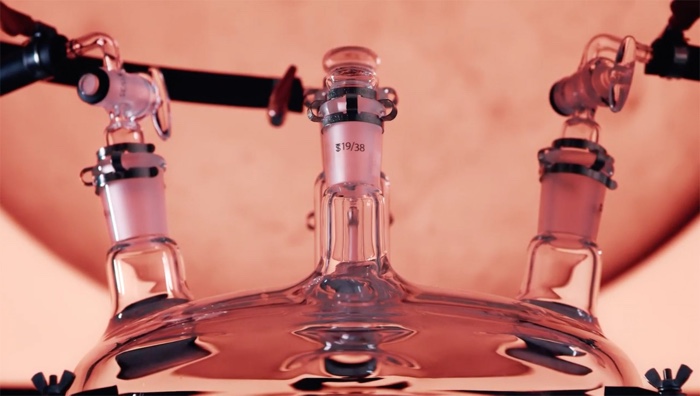The Art-Science Symbiosis, by biologist and Director of the Fundación Arte + Ciencia Chile Marcelo Velasco and Ignacio Nieto from University Finis Terrae, both authors from Santiago, Chile. Published by Springer-Verlag.

Just like scientific practices can pull art out of its prissy self-referentiality, art can help sciences step out of their hyper-specialised alcoves by fleshing out the ethical and cultural dimensions associated with their research and by devising novel ways to interact with the public.
The Art-Science Symbiosis presents the diversity of art-science integration, highlighting the potentials, obstacles and methods that enable both worlds to challenge each other and make emerge new types of knowledge.

The Elephant Clock from “The Book of Knowledge of Ingenious Mechanical Devices” by Ismail al-Jazari, 1206

Alphonse Bertillon, Anthropometric data sheet, 1912
The main target group of the book are scientists who want to experiment with art and artistic collaborations. It seems to me, however, that artists, students in humanities or anyone else might find the book interesting. On several grounds:
The first one is the fascinating section that explores historical antecedents of art-science integration, with examples that range from The Book of Knowledge of Ingenious Mechanical Devices, where polymath Ismail al-Jazari described the automata and mechanical devices used in 12th century Islam to Athanasius Kircher’s Magnes sive de Arte Magnetica; from Maria Sibylla Merian’s delicate illustrations of insects and flowers in Metamorphosis insectorum Surinamensium to Étienne-Jules Marey’s Marey shaking a flexible rod.
Another strength of the book is the chapter that presents 22 recent works. Each text, written by the authors of the works, provides insight into their motivations, the material and techniques used, the conceptual criteria adopted, the possible significance of the artwork for scientific research, the communication and exhibition strategies, etc.

Kathy High, Blood Wars (Separation of red and white blood cells from human blood sample. SymbioticA), 2010– 2011

Rachel Mayeri, Primate Cinema: Apes as Family, 2011
The range of scientific disciplines these artworks engage with is wide: mathematics, microbiology, neuroscience, finance, immunology, ethology and more. Some more spectacular, more poetical, or more speculative than others.
The following chapter completes the artwork description with a series of insights that Nieto and Velasco have gathered through their interviews with the artists and scientists. Their analysis of the answers dives deeper into the relationship between artists and scientists and between them and the public, the differences of their respective approaches; the kind of debates they want to raise with the collaborations; the implications of an art-science synthesis; the challenges of conserving pieces of work that are “alive”. And so much more.

Philippe Parreno. Exhibition view:Gropius Bau, Berlin, 2018. Photo: Andrea Rossetti

Gilberto Esparza, Plantas Nómadas, 2008 – 2014
The last chapter is a practical guide for scientists who would like to add an artistic dimension to their research. The step-by-step process is designed with care, but there’s no mention of one of the most critical aspects of any art-science experiment: how to finance them.
The chapter also presents several art-science current initiatives and graduate programs around the world. That part is precious. There’s the usual US, Australian and European references but also a list of equally exciting organisations in Latin America, China, Japan and South Korea.
I really enjoyed the book. It is concise, efficient and never goes for the obvious references, names, or perspectives. Its language is approachable and it covers a surprising amount of questions in less than 200 pages. Bonus: plenty of photos of current artworks and historical artefacts.

PЯOTO-ALIEИ PЯOJECT, Formata. Non-terrestrial, Kinetic and Autonomous Agents (detail), 2020–2023

PЯOTO-ALIEИ PЯOJECT, Formata. Non-terrestrial, Kinetic and Autonomous Agents (exhibition view at Ars Electronica 2023), 2020–2023. Photo: vog.photo

Yunchul Kim, Impulse, 2018

Susana Soares, Bee’s, 2007–2009

Paul Vanouse, Labor (Martin, Front: seat-stain-transfer print, 2018), 2019
Related book reviews: This Is NOT An Artifact, Green Revisited: Encountering Emerging Naturecultures, Reconnecting with your dirty and harshly geological self, The Anthropocene Cookbook. Recipes and Opportunities for Future Catastrophes, Routledge Handbook of Art, Science, and Technology Studies, Art’s Work in the Age of Biotechnology. Shaping Our Genetic Futures, Art as We Don’t Know It, Taboo ‒ Transgression ‒ Transcendence in Art & Science, etc.







